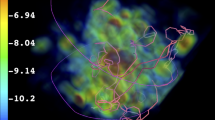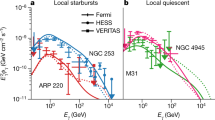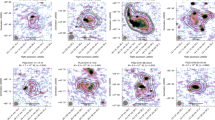Abstract
AT energies above ∼ 1017 eV it becomes increasingly difficult to maintain the observed near isotropy of ultra high energy cosmic rays if they are of Galactic origin, unless there is an extensive halo magnetic field, and the primaries are heavy nuclei1; instead, extragalactic origin is often assumed. The models proposed can be divided into three main groups: (1) ‘universal’, in which there is a class of galaxies in the Universe (of which our own is not a member) which are roughly uniformly distributed, and which generate the ultra high energy particles; (2) ‘universal plus supercluster enhancement’2, in which the existence of a supercluster is assumed—the enhanced density of galaxies in the SC allows a larger fraction, than is its share by volume, to have come from this region; and (3) ‘Supercluster trapping’3, where energetic phenomena in the SC generate the particles which are then trapped for periods of perhaps 109–1010 yr.
This is a preview of subscription content, access via your institution
Access options
Subscribe to this journal
Receive 51 print issues and online access
$199.00 per year
only $3.90 per issue
Buy this article
- Purchase on Springer Link
- Instant access to full article PDF
Prices may be subject to local taxes which are calculated during checkout
Similar content being viewed by others
References
Osborne, J. L., Roberts, E., and Wolfendale, A. W., J. Phys. A., 6, 421–33, (1973).
Strong, A. W., Wdowczyk, J., and Wolfendale, A. W., J. Phys. A., 7, 1767–1776, (1974).
Brecher, K., and Burbidge, G. R., Astrophys. J., 174, 253–91, (1972).
Greisen, K., Phys. Rev. Lett., 16, 748–50 (1966).
Zatsepin, G. T., and Kuzmin, V. A., Soviet Phys. JETP, 4, 114–7 (1966).
Bell, C. J., et al., J. Phys. A., 7, 990–1009 (1974).
Edge, D. M., et al., J. Phys. A., 6, 1612–34 (1973).
Proc. 14th Int. Cosmic Ray Conf., Munich (Max-Planck-Institut für Extraterrestriche Physik, München, 1975).
Tkaczyk, W., Wdowczyk, J., and Wolfendale, A. W., J. Phys. A., 8, 1518–1529, (1975).
Berezinsky, V. S., Grigoreva, S. I., and Zatsepin, G. T., Proc. 14th Int. Cosmic Ray Conf., Munich, 2, 711–716 (Max-Planck-Institut für Extraterrestrische Physik, München, 1975).
Hillas, A. M., Proc. 14th Int. Cosmic Ray Conf., Munich, 2, 717–722 (Max-Planck-Institut für Extraterrestriche Physik, München, 1975).
Puget, J. L., and Stecker, F. W., Proc. 14th Int. Cosmic Ray Conf. Munich, 2, 734–738 (Max-Planck-Institut für Extraterrestriche Physik, München, 1975).
Watson, A. A., Proc. 14th Int. Conf. on Cosmic Rays, Munich, Rapporteur dader, 11 (in the press).
Author information
Authors and Affiliations
Rights and permissions
About this article
Cite this article
WDOWCZYK, J., WOLFENDALE, A. Energy spectrum of ultra high energy cosmic rays. Nature 258, 217–218 (1975). https://doi.org/10.1038/258217a0
Received:
Accepted:
Issue Date:
DOI: https://doi.org/10.1038/258217a0
Comments
By submitting a comment you agree to abide by our Terms and Community Guidelines. If you find something abusive or that does not comply with our terms or guidelines please flag it as inappropriate.



